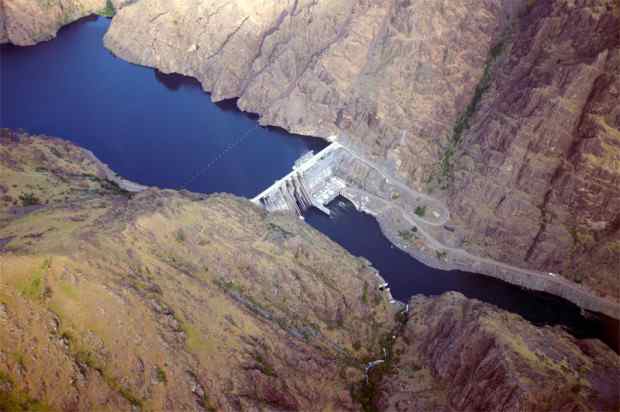forum
library
tutorial
contact

Idaho Dams Must be Part
of Fish Discussion
by Fred Mensik
Tri-City Herald, February 11, 2020
|
the film forum library tutorial contact |

|
Idaho Dams Must be Part
by Fred Mensik
|
Safety in number occurs when being part of a large group is safer than being alone against similar predator pressure.
 Last October, I attended a meeting in Moscow, Idaho held by the Friends of the Clearwater, where none of the biologists talked about lost salmon productivity in Idaho.
Last October, I attended a meeting in Moscow, Idaho held by the Friends of the Clearwater, where none of the biologists talked about lost salmon productivity in Idaho.
The entire agenda was dedicated to the removal of the Snake River dams. But the Friends of the Clearwater are friends of only certain Clearwater River tributaries. Dworshak Dam's construction devastated the steelhead and chinook populations of the Clearwater River. Salmon abundance requires adequate salmon productivity. But no one was complaining about Dworshak Dam.
I attended a Forum on Salmon, Steelhead and the Outfitting Industry in December at the Clearwater Casino, where one of the speakers stated that after 25 years of study, there is only one option, which was to remove Lower Snake River dams.
The assumption is incorrect.
Those studies prove that dams are not good for fish. But, for 45 years the Lower Snake River dams have been passing fish to and from Idaho.
Now compare any of the four Lower Snake River dams to Dworshak Dam. Built on the North Fork of the Clearwater River, Dworshak is 717 feet tall and has no fish ladder. This single dam has eliminated 60% of all Clearwater River steelhead and up to 70% of all Clearwater River chinook.
While Friends of the Clearwater and the Outfitting Industry point fingers at Washington dams, they ignore devastated salmon populations in their own backyard. At this meeting, Ed Bowels, fish manager for the State of Oregon stated that all sacred cows should be on the table for discussion. But, no one is discussing Idaho dams.
The most recent meeting I attended was held at the Quality Inn in Clarkston in January. The meeting was part of the $750,000 Washington state effort to gather opinions about the effects of keeping or removing Lower Snake River dams. At that meeting, the panel spoke about maintaining the dialogue. Unfortunately, no one identified that the problem is in Idaho.
Safety in number occurs when being part of a large group is safer than being alone against similar predator pressure.
But when the numbers of the group are diminished to less than 25% of the original group size, than the individual is 75% less successful against the same amount of predator pressure.
Idaho has dammed up 40% of all salmon habitats. That 40% produced more fish than the remaining undamned 60%. As a result, salmon produced from the remaining 60% will be eaten at a higher percentage rate because of diminished population.
This is why Salmon River fish are not returning. They are eaten in the ocean at a higher rate than when all of Idaho's rivers were free flowing.
In 1953, Forrest Hauck, fish biologist for the State of Idaho stated: "The controversial Hells Canyon issue doesn't look so bright. Either Hells Canyon dam (over 600 feet high) as proposed by the Bureau of Reclamation, or the series of three dams (with a combined height of over 600 feet and Brownlee exceeding 300 feet) will prevent the upstream passage of fish. At least there are no known, successfully operated fish-ways over 100 feet high. These dams, if constructed, will stop the runs of steelhead up the Snake and Weiser rivers, the spring chinooks up the Weiser, and the fall chinooks up the Snake river."
Forrest Hauk predicted the loss of the Snake River Fall chinook due to Idaho dams. Washington dams did not cause this problem because they do not block fish from their upper Snake River spawning habitat.
It did not take 25 years to eliminate the Payette system sockeye. It only took 14 years after Black Canyon Dam was completed for the last of the Payette system sockeye to become extinct.
It took only four years of observation to see steelhead numbers plummet after the construction of Dworshak Dam. It was only two years after Brownlee Dam was completed for Idaho fish biologist to know the Snake River fall chinook were in trouble.
The Oxbow Dam construction fish kill started as the soon as the forebay started filling. A video of this can be found on YouTube -- search Oxbow Dam Construction Accidental Fish Kill.
When we ignore history and fail to acknowledge the real cause of salmon and steelhead declines, we will move in the wrong direction, continuing to make dam mistakes. Idaho needs to be part of Washington Gov. Jay Inslee's $750,000 study. Washington residents need to raise this issue.
Related Pages:
Be Informed About Dam Removal to Help Northwest's Salmon by Fred Mensik, Idaho Mountain Express, 9/5/18
FEEDBACK: Salmon Extinctions by Fred Mensik, Columbia Basin Bulletin, 2/8/8
Defining High Cost, Low Value Dams by Fred Mensik, Columbia Basin Bulletin, 10/20/6
Sources Of Mortality for Snake River Fall Chinook by Fred Mensik, Columbia Basin Bulletin, 7/28/6
Lower Snake Dams and Sockeye Salmon by Fred Mensik, Columbia Basin Bulletin, 6/23/6
learn more on topics covered in the film
see the video
read the script
learn the songs
discussion forum
